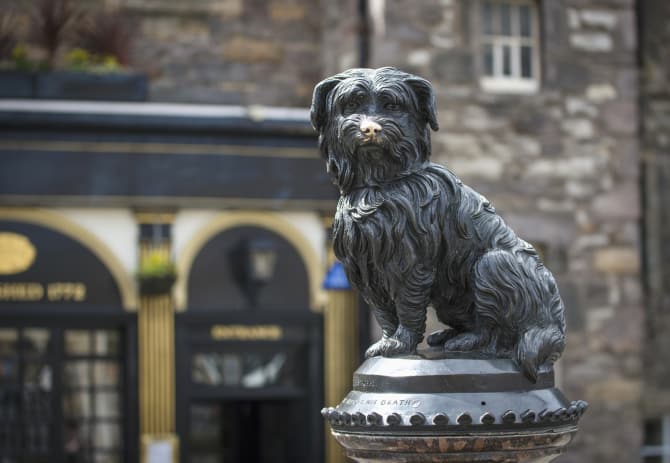
It is believed that if you rub the nose of the Greyfriar’s Bobby statue in Edinburgh (pictured) it will bring good luck!
EDINBURGH, Scotland, 2016-Dec-23 — /Travel PR News/ — Very Superstitious….
Friday the 13th and how Scotland ‘invented’ the superstition
Friday the 13th of January might be a day when people are overly aware of black cats, groups of magpies and not walking under ladders; but many might not realise that Scotland is the home of many superstitions, myths and legends.
In fact many of the most commonly held superstitions originate from the home of the Loch Ness Monster….
Examples of superstitions that have originated in Scotland include:
- In the north of Scotland, some farmers believe that the birth of a black-faced sheep brings bad luck for all the flock – this is where the expression ‘black sheep of the family’ originates. If a sheep has twins, both born with black faces, this signals a poor lambing season ahead.
- It’s considered lucky to place silver in a new born baby’s hand as it will bring great wealth to them in later life.
- Also, a person should touch iron if they see or even hear evil.
- A bride should place a silver coin in her shoe or carry a sprig of heather for good luck.
- In Scotland, a baby born on the first day of the month is considered to be lucky. Also, what day a baby is born on has an impact on its future. The famous ‘Monday’s child is fair of face…’ poem originates from Scotland.
- First Footing on Hogmanay – In the New Year, Scottish people “first-foot” one another, which means to be the first into somebody else’s home. The first-footer must bring a gift into the home to bring good fortune for the coming year. This most likely developed because of the fair-haired Vikings invasion of Scotland in the 8thcentury.
- Today, the tooth fairy that leaves money under a pillows in exchange for teeth. This highly resembles an old Scottish superstition about lost teeth that is supposed to bring a child good luck and strong teeth.
- It has been said that Scotland in fact invented the tradition of Halloween and the superstitions and traditions around it. The tradition of ‘dookin’ for apples, where children (and sometimes adults) attempt to retrieve apples from a water-filled basin using only their mouths is thought to be a reference back to the days of the druids. In ancient druid lore, apples were said to be a very sacred fruit.
- Scottish seafarers too often believe that salmon are bringers of bad luck and are known as the ‘reid fish’. Salmon was at one time known as a sacred creature.
Places to explore Scottish superstition, myths & legends…
- Edinburgh – visit Greyfriar’s Kirk and the nearby statue of Greyfriar’s Bobby and rub his nose for good luck (the paint on his nose has actually started to wear off due to the number of ‘rubs’!)
- Stonehaven, Aberdeenshire – and chat to a local fisherman about his or her beliefs and superstitions.
- Rosslyn Chapel, Midlothian – believed to be final resting place of the Holy Grail.
- See in ‘first footing’ in the New Year after the Comrie Flambeaux fire festival in Perthshire; a spectacular events that kick off the new year with a serious and uniquely Scottish bang.
- Find a lucky sprig of heather across Scotland – heather blooms twice a year in early summer and early autumn. For a classic route across heathery mountain ground, travel from near Ballater in Deeside along the A939 to Tomintoul and Grantown-on-Spey.
- Check out the horseshoes (considered lucky) at the Famous Blacksmith’s Shop in Gretna Green, Dumfries and Galloway; now a wedding venue and visitor attraction. There are horseshoes set in an archway at the entrance to the exhibition that is a popular spot for pictures.
- Get in the spirit of Halloween superstitions with a visit to one of the many rumoured ‘haunted’ spots in Scotland; including the Drover’s Inn pub in Glasgow or Culzean Castle in Ayrshire.
- It goes without saying that Loch Ness is reputed to be the home of Nessie, the Loch Ness Monster. Around one million people visit Loch Ness each year, generating around £25 million for the local economy.
For more information on myths, legends, ghosts and superstitions check out the VisitScotland Myths and Legends e-book at www.visitscotland.com/hha2017
Notes to editors
About VisitScotland
- VisitScotland launched its global Spirit of Scotland campaign in 2016. To find our more go to www.visitscotland.com Join the conversation by using #ScotSpirit
- Spirit of Scotland PR activity is part financed by the European Regional Development Fund Programme 2014 to 2020. The Scottish Government is the managing authority for the European Regional Development Fund Programme.
- VisitScotland’s Community site was set up for the Scottish public to help, engage and enthuse potential visitors about the country. To get involved go to: www.visitscotland.com/community
- For holiday information on Scotland go to www.visitscotland.com
- For VisitScotland’s press releases go to http://www.visitscotland.org/media_centre.aspx, tourism statistics and frequently asked questions go to http://www.visitscotland.org/
2017 Year of History, Heritage and Archaeology
- 2017 is the year to delve into the past and discover Scotland’s fascinating stories through a wide-ranging variety of new and existing activity to drive the nation’s tourism and events sector, boosting tourism across Scotland.
- The Year of History, Heritage and Archaeology begins on 1 January 2017 and will end on 31 December 2017. It will build on the momentum generated by previous themed years in Scotland including the 2015 Year of Food and Drink, Homecoming Scotland 2014, the Year of Creative and the Year of Natural.
- The Year of History, Heritage and Archaeology is a Scottish Government initiative being led by VisitScotland, and supported by a variety of partners including Creative Scotland, Scottish Tourism Alliance, Scottish Enterprise, The National Trust for Scotland, Historic Environment Scotland, Highlands and Islands Enterprise, Built Environment Forum Scotland, Heritage Lottery Fund, Museums Galleries Scotland and Traditional Arts and Culture Scotland.
- The Year of History, Heritage and Archaeology is supported by £570,000 of Scottish Government funding.
- The Year of History, Heritage and Archaeology events fund is managed by EventScotland, part of VisitScotland’s Events Directorate.
- For more information visit visitscotland.com/HHA2017 or join the conversation at #HHA2017
SOURCE: VisitScotland
MEDIA CONTACT
Erin Hickey
Assistant PR Manager – UK & Ireland
Erin.Hickey@visitscotland.com
0131 472 2030

